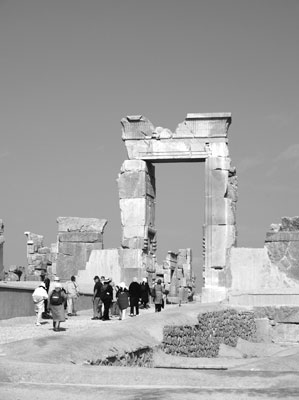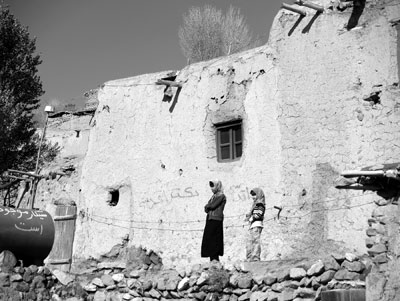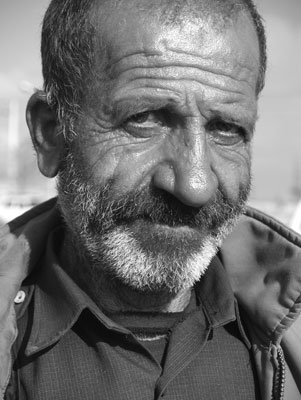Into Iran—finding warm greetings and fascinating fabled cities
by Yvonne Michie Horn, Santa Rosa, CA
As is usual toward the end of a long flight, my eyes were on how much longer and how much farther the screen that folded out from my armrest indicated we had to go.
As the little drawing of the plane inched toward Tehran, something quite different appeared in one corner of the route map. My first noticing of it read “Mecca 1,926 km,” with an arrow pointing out the direction. While I was surprised to see it, this directional underscored what I already knew: I was on my way to a country where, to the majority of those living there, knowing the direction of Mecca is of high importance.
Given that, I had something in my carry-on to slip into as we neared Tehran, a coat-like affair that would cover me neck to knees and shoulders to wrists, along with a scarf to ensure that not a bit of hair would show. This would be my daily costume, outside the privacy of my hotel room, for the next three weeks.
The lure of discovery
An ElderTreks 2008 catalog was responsible for my taking this journey. With a flip of a page, the title “Iran, Persian Highlights” stopped me dead in my tracks with the realization that here was an opportunity to visit an ancient land of poetry and beauty, a nation declared a member of the “Axis of Evil” by our past president, a country that has evolved as all important to the fast-moving “history in the making” of the Middle East.
Two departures were listed, one in the spring and the second in the fall, both with 19 land days. Deciding on the November itinerary, I set about searching for possible flights. The one that was the most convenient and affordable from my departure city, San Francisco, entailed my arriving in Tehran two days earlier than the rest of the tour group.
In the wee hours of the morning, the British Midland plane to which I’d transferred in London touched down (most international flights to Tehran arrive between midnight and dawn). As promised by ElderTreks — and to my grand relief, as I was traveling alone — a man holding a placard bearing my name was waiting for me in the arrival hall and I was whisked away by taxi to the timeworn and modest but comfortable Howeyzeh Hotel in central Tehran, a 35-kilometer drive away.
Venturing out
The next day I peered out my room’s window to the street below. There was not a woman in sight. Was it forbidden for women to venture forth on their own? Was it safe for me, as an American?
Unwilling to spend the next two days in my room, I got into my cover-up, gave my scarf a securing tug, descended to the lobby and walked out the front door to discover that many women were out and about.
Emboldened, I walked around the block, returned to the lobby, pulled out my Lonely Planet guidebook and approached the desk to have the name of where I wanted to go written on one of the hotel’s cards in Farsi.
As I set forth to my destination, the Carpet Museum, about an hour’s walk north of my hotel, an immediate problem presented itself: how does one cross the street? Tehran’s horrendous tempest of traffic whizzed by in all directions with little regard for stoplights.
Seemingly everyone in this city of some 14 million owns a car, most of which are the ultra-inefficient Paykan, a no-frills Iranian-built vehicle largely responsible for the inevitable invisibility of the snowcapped Alborz Mountains only 20 kilometers away.
Standing on the curb, I quickly concluded that my best bet was to wait for a group of people to assemble, stand in their midst, take a deep breath and sally forth, taking slim comfort from the fact that in Iran if a vehicle hits a pedestrian, the driver is automatically at fault.
En route to the Carpet Museum’s display of more than 100 items dating from the 17th century to the present, I peered into shops and took shortcuts through parks. The next day I headed in the opposite direction to the Glass & Ceramics Museum, housed in an architecturally significant Qajar-era residence. There I spent an hour or so admiring its extensive, jewel-box collection of exquisitely exhibited examples dating from the second millennium.
Warm greetings met me as I paid museum entry fees, the equivalent of about 50 cents, where I was invariably spotted, despite my garb, as an American. How they knew was hard for me to figure out and a question that followed me throughout my time in Iran.
Why did they not assume I was from Germany, the UK or any number of European countries from which visitors have long come? With the US and Iran at odds since the mid-20th century, it is only recently that a few Americans have begun to venture to this intriguing land.
Introductions
With all 14 members of our group having arrived, we met for a briefing.
Leon van Neer, a longtime ElderTreks guide with a wealth of expertise on the Middle East, would be our leader. Maliheh Shiralipour, introduced as our Iranian national guide, would travel with us to provide information and insights throughout the tour. Gulin Pazaroglu, an experienced tour leader from Turkey, joined us to preview the itinerary, as he would be replacing Leon on future journeys.
After introductions, Leon laid down the rules. The Iranian government had approved our itinerary, and there would be no deviations. We would be watched to make certain that was so. For “security reasons” there would be no home or school visits. Photographers were told to take extreme care to avoid taking shots of anything that might be deemed sensitive, and we were warned to stay with the group — no wandering off by oneself.
I listened with amazement. How could it be that I’d walked about so freely for the past two days?
My journey begins
Tehran would be both the starting and ending point of our explorations, which would take us as far north as Bandar-e-Anzali, on the edge of the Caspian Sea, and as far south as Shiraz, city of poets and gardens.
While in 19 days it would be impossible to cover the entirety of this vast country’s more than 630,000 square miles, we’d traverse mountain ranges with peaks over 13,000 feet, descend into high-plateau desert country and visit fabled cities such as Isfahan, home to the Safavid empire’s finest architectural jewels.
Days would be devoted to immersing ourselves in the stories and magnificence of the First Persian Empire, the greatest empire the world had known before it was brought to its knees in 330 BC by Alexander the Great.
After visiting Pasarghad (Pasargadae), begun by Cyrus the Great in 546 BC, and the austere tomb of Cyrus that stands proudly on a windswept plain among remnants of once-grand palaces, we continued on to the ruined grandeur of Persepolis.
We climbed the grand staircase that leads to entry gates through which foreign delegations once arrived, their entrance heralded by trumpeters at the top of the staircase. (We saw fragments of these trumpets in Persepolis’ museum.)
While Persepolis was designed and built to strike awe and illustrate Persia’s power as a conquering empire, at the same time, as surviving friezes indicate, the Persian empire was one of antiquity’s more glorious and benevolent civilizations — a thought to ponder as our journey continued on to tally visits to six of Iran’s nine UNESCO World Heritage Sites.
Yazd
In Yazd, an oasis in the middle of the harsh desert described by UNESCO as one of the most historic cities in the world, we walked the winding lanes of the mud-brick Old Town.
Yazd is home to Iran’s largest Zoroastrian community, the main religion across the Iranian plateau before the Arab conquest brought Islam to the fore. Our first encounter with Zoroastrianism had taken place a few days earlier when we traveled high into a lonely bowl of mountains to the ruins of Takht-e-Soleiman, the sect’s ancient spiritual center built around a limpid, supposedly bottomless lake. It is, without question, one of the most memorable sights of western Iran.
In Yzad we visited Ateshkadeh, the Fire Temple, with its sacred eternal flame. Brought to Yazd in 1474, it is said to have been burning since about AD 470. Here we climbed the Tower of Silence, where dead bodies once were laid so that vultures might pick them clean, preserving the purity of the Earth.
Memorable encounters
We had seen grand mosques and mausoleums, impressive ruins and fabled cities, yet, as so many intrepid travelers have learned, unexpected interactions and happenings often supply a trip’s most unforgettable moments.
Before leaving the lush, tea-plantation area in the north, we visited the village of Masuleh, at least a millennium old, its earth-colored houses climbing a cupped mountainside so steeply that the roof of one formed the pathway for the next. In a tiny shop there I bought a candy bar from a young shopkeeper who spoke perfect, idiomatic English.
“How did you learn?” I asked.
“I taught myself,” was his answer. “You can do anything if you want to badly enough.”
The candy bar I bought from him pictured George Washington on its wrapper.
One evening we went to a zurkhaneh, meaning “house of strength.” Unique to Iran and dating back thousands of years, what takes place there lies somewhere between sport, theater and religion.
In a gymnasium-like building, we were the sole non-Iranian spectators among those gathered around a sunken, circular area to watch a series of ritualized feats of exercise taking place. Most involved whirling and jumping about while waving bowling-pin-shaped clubs of varying weights, all accompanied by a frenetic drumbeat and the reading of verses of Iranian epics and poetry.
Serendipitous stops
ElderTreks’ brochure told us to expect long drives. With our gentlemanly expert driver, Siavash Mazemi, at the wheel of the small bus, the hours-long drives over spectacular mountains, into lush valleys of fruit orchards, wheat fields and grapes and through small settlements where villagers smiled a welcome and waved offered some of the trek’s most rewarding days.
An emergency toilet stop at a high, barren mountain settlement allowed us to break the “no visits to schools” rule. Noticing children walking into a building, we stopped so Maliheh could ask the teacher if we might use the facilities. Rudimentary they were, but the gracious invitation by the teacher to enter his classroom to visit with the children became a journey highlight.
Two tea stops remain indelible. The first, on an afternoon turned drizzly and cold, was in Isfahan following a visit to the summer palace Hasht Behesht. We gathered at a cozy teahouse in the palace gardens to down countless cups of steaming tea and munch on crispy sesame cookies.
The second tea stop was in a tree-shaded park with platforms for groups of tea drinkers — and water-pipe smokers — built over a bubbling creek where the more adventurous among us improved their expertise at blowing smoke rings.
As we traveled, I expected to see evidence of anti-American sentiment. With two exceptions, that was not so. One was a faded graffito, “Down with USA,” scrawled on an abandoned farmhouse in the north. The other, in Tehran, was on the side of the building now known as the US Den of Espionage museum. It was once the American Embassy.
Both sightings were completely at odds with the warm, welcoming attitude of every Iranian we met along the way.
Shopping surprises
Hotel accommodations ranged from clean and modest to downright luxurious, such as Abbasi Hotel in Isfahan, a 17th-century caravanserai rebuilt around a gloriously gardened interior courtyard, where we spent three nights.
Three nights were needed to take in the glorious sites of Isfahan and to give the shoppers among us the opportunity to explore the bazaar surrounding the spectacular, tiled buildings of Iman Square. Even I, a dedicated nonshopper, found wandering Isfahan’s bazaar fascinating, stopping to watch artisans at work and taking time out to watch the passing parade over a cup of tea.
While every aspect of the trip was covered in ElderTreks’ 2008 price tag of $4,995 — food, hotels, admissions and transportation within the country — American visitors to Iran should know that credit cards and ATMs cannot be used. Purchases must be covered by the amount of cash brought into the country, exchanged into rials.
When one of our group showed up toting a quite large rug packed into a handled bag to carry home on the plane, we asked how she was able to pay for it. No problem! The shopkeeper had put his trust in her, with instructions to send a check to his brother who lived in New York when she got home.
Midway through our days together, it occurred to the women in our group that we’d not seen each other’s hair. One evening after dinner, we gathered in a hotel room, women only, whipped off our scarves and, with Maliheh providing Iranian music, danced wildly about — another Iranian moment to long remember. ITN
Yvonne Horn was a guest of ElderTreks (Toronto, Canada; 800/741-7956, www.eldertreks.com), which covered the land portion of her scheduled tour.







